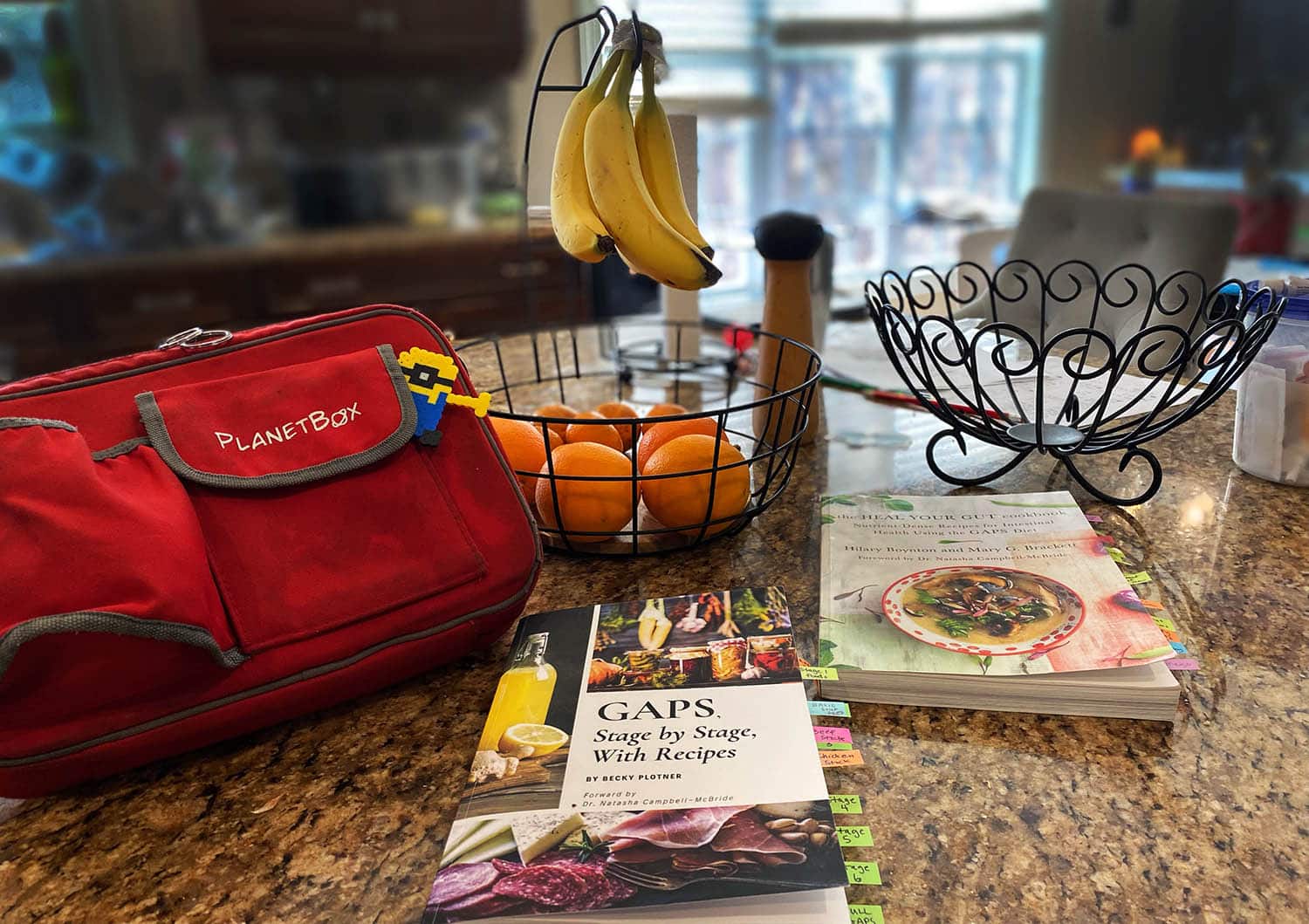I’m excited to introduce my first-ever GUEST BLOGGER!
Meet Lynn, one of my dearest friends from way back — we met in the 7th grade! In the years (okay decades) since then, we’ve both gravitated toward similar interests in ancestral health and natural, low-toxin living and find ourselves now with even more in common than we did as kids.
She’s also my Wise Traditions Conference buddy — we’ve been to 3 together so far (woot!) ♥
Hi! I’m Lynn, mom of three boys and a total (unconventional) health nerd. I love to learn and share with others about all things nourishing, traditional and different from mainstream thinking.
My family decided to embark on a healthier eating journey starting January 1. We committed to healthy homemade dinners every single night, no fast food at all and very minimal eating out. The style of eating we decided on is called the GAPS diet, a gut healing nutritional protocol designed by Dr. Natasha Campbell-McBride.
Our family consists of me, my dear husband (DH), who is 44, my mother who is 69, and my dear sons, DS14, DS11 and DS9.
What is GAPS? Why do it?
The GAPS protocol, which stands for “Gut & Psychology Syndrome” or “Gut & Physiology Syndrome,” emphasizes the connection between gut health and overall health. By improving gut health, it aims to alleviate a wide range of conditions, including allergies, autism, dyslexia, autoimmune disorders, and chronic diseases that have an autoimmune component. For a full review, see Let’s Talk About GAPS and Preparing For GAPS.
Why did we choose this?
In addition to general health enhancement, we did have various maladies in the house we wanted to address. From knee and back pain that was interfering with daily activities for my mother to picky eating and lack of energy and appetite with the kids. We also recognize that, in our lives, we have been and continue to be exposed to antibiotics, heavy metals, pollution, EMF, etc. and that all of our guts could use a healing break.
Ok, here’s the meat of the article. If you came for the tips and tricks, here we go! Here is a list of the things we did that I think really helped us get the most out of our GAPS diet experience.
Remove naughty foods
Take it all away! It seems crazy and looks dramatic, but let me tell you this was key. We got some large plastic storage bins and removed everything from the pantry that we didn’t want to be eating. This included rice, flours, chips, tortillas, sugar, candy, oatmeal, hot chocolate packets and much more. If those things were simply on higher shelves or shoved to the back, I am sure we would not have done as well as we did. We also have the luxury of an extra refrigerator in our garage, so I was able to hide the maple syrup, jelly jars and so on.
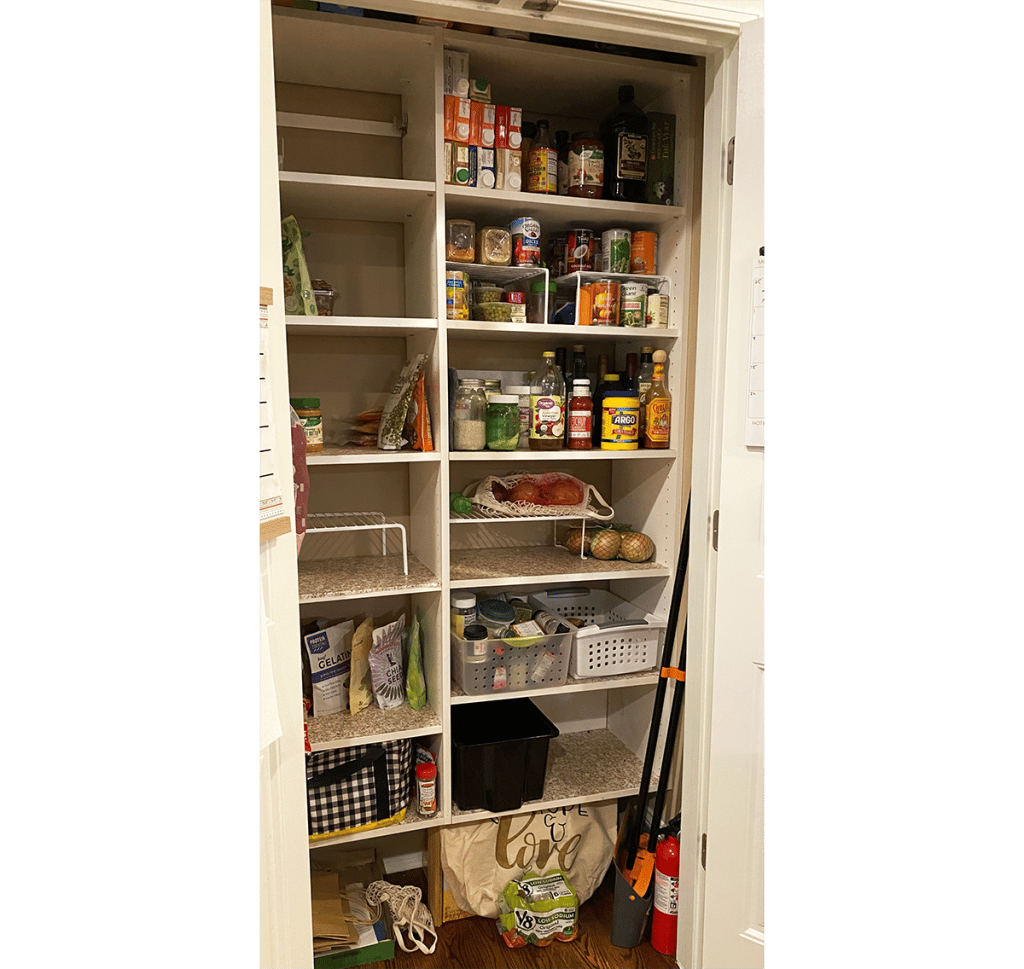
Our plan was to stick to the diet really strictly for an entire month. After that, we would adjust and figure out a plan going forward. But for that month, we were committed. This made the process a lot easier and less scary for the family — their much-loved items weren’t gone for good. They were just gone for now.
(Throughout the month I certainly got some ideas for some mysterious disappearances that may occur in the bins before they returned, but that’s my little secret!)
Make a plan
Number one: have an overall game plan.
Decide how long you are aiming for. Get agreement from the adults about how much they plan to participate. They all need to either buy in or at least agree to not derail the others. For example, for my family, my mother and I did Introductory GAPS (basically a soup-based elimination diet), the kids did Full GAPS, and my husband did Full GAPS plus whatever he chose to add (such as Starbucks a few times a week and finishing the last of the ice cream in the freezer — the one thing I forgot to remove!) Get everyone very clear on what you’re doing and for how long.
It’s also helpful to have a plan for what to do if anyone doesn’t wish to eat the dinner you made. For those of you with picky eaters in the house, you know what I’m talking about. In our house, the rule is that you must try a bite of everything at dinner. If you don’t like what was served, you may have unlimited hard boiled eggs. If you get hungry after dinner, the options are leftover dinner or hard boiled eggs.
Meal plans! I love executing a meal plan. I love being told what to make and then just making it. What I do not love is creating the meal plan. Deciding what’s for dinner. Every. Single. Day. Like forever. It’s exhausting. But I realized shortly before we started this that the times we would bail out and order pizza or go grab something to eat at a restaurant were when we didn’t know what to eat at home. The number of options in the fridge and pantry are almost independent of this phenomenon.
So, with a strict new eating plan in place, I knew that what I would need was a list of what to eat. What to eat at every meal, and for every hunger that would come up in between. Here’s how we tackled this:
Breakfast
Create a list of some basic breakfast options, using food items that are kept on hand at all times:
- eggs! (typically scrambled or fried)
- uncured, sugar free bacon
- yogurt, served most often as a parfait with things like chopped crispy nuts, fresh berries, unsweetened shredded coconut and honey
- squash pancakes, made with nut flours or nut butters and lots of eggs
- smoothies (after you decide on a base of liquids — our favorites are kefir or yogurt and coconut water — add frozen fruit and all sorts of healthy things)
Lunch
- leftovers
- monkey platter
- frozen 100% beef burger patties
Two of my children are homeschooled, and so we do have a number of people home for lunch most days. Our plan for lunches each day was kept pretty simple. We’d have either leftovers, something we do called a “monkey platter,” or if neither of those sounded good, frozen 100% beef burger patties, cooked up and eaten with no bun.
What is a monkey platter? We received a lovely white, sectioned platter for a wedding gift years ago and I didn’t find much occasion to use it until I heard about this idea. Monkey platter is simply a variety of finger foods displayed in an easy to serve way for folks to have as a snack or as lunch.
The options are endless:
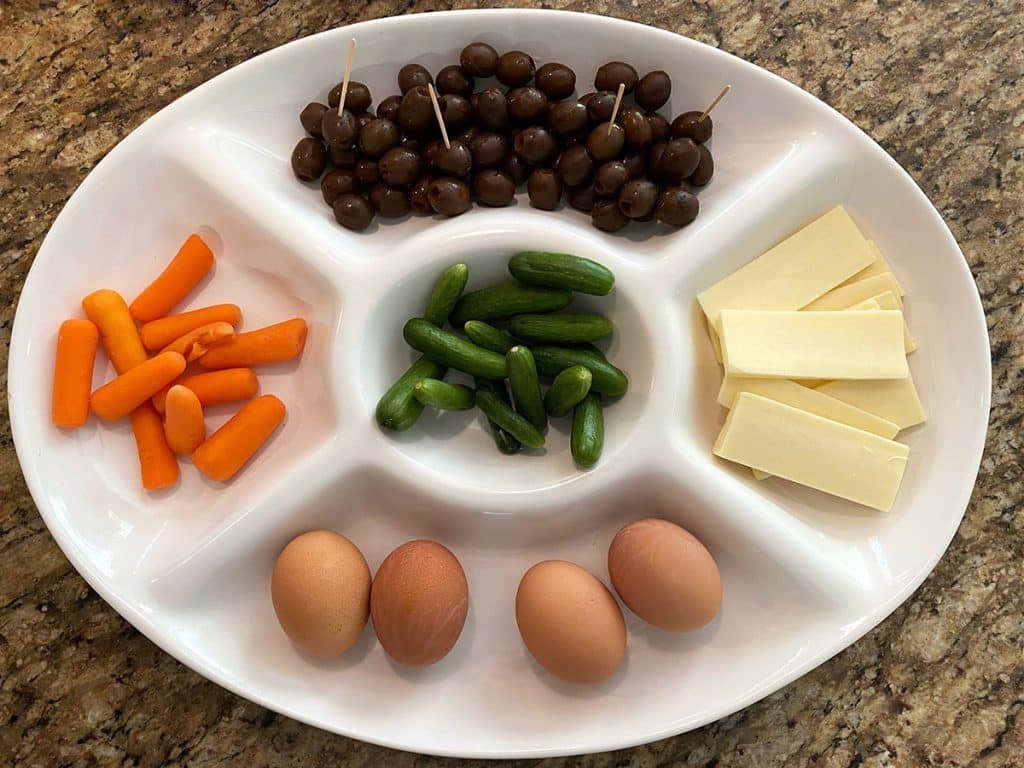
I’ve put things like cheese slices, fruit, cut up veggies, deli meat, leftover pancakes from breakfast, etc. Sometimes I just open the fridge and set out whatever needs to get eaten up.
Monkey platter for one:
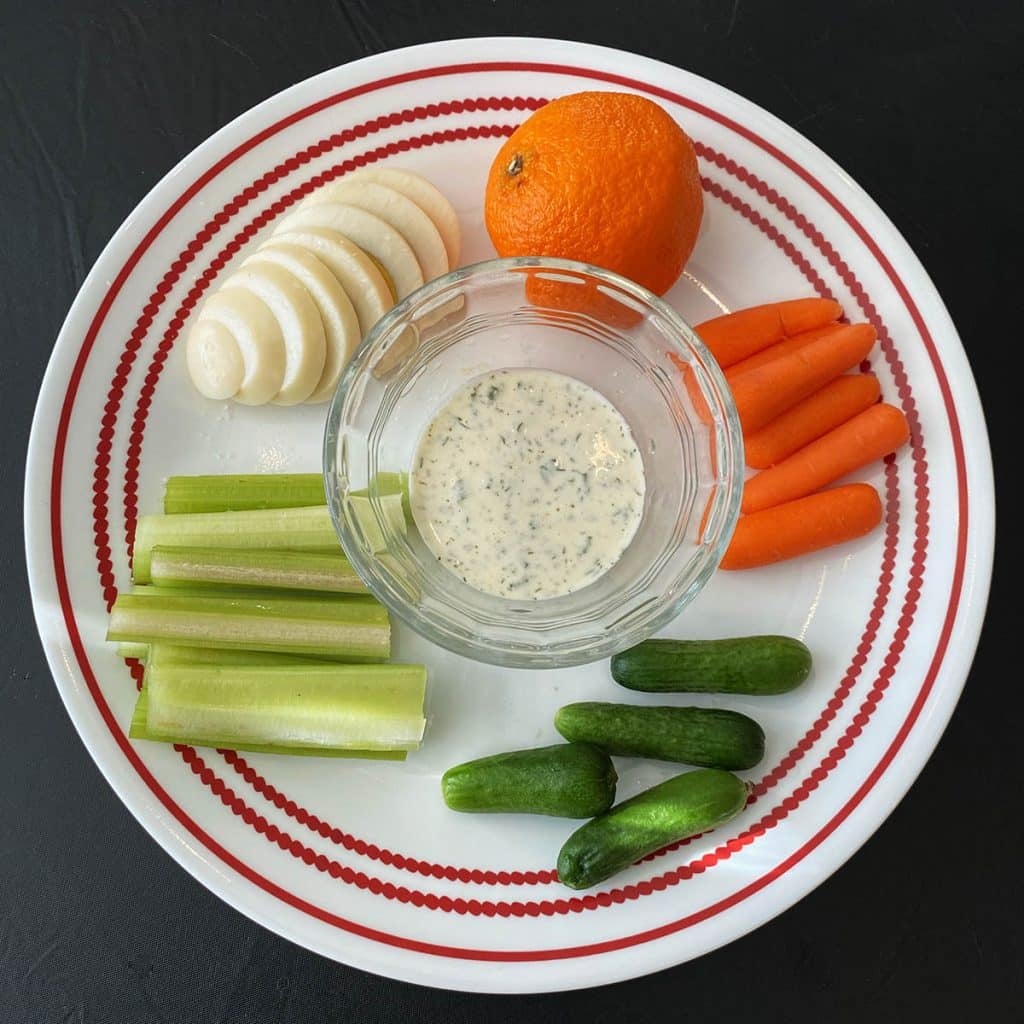
* A special note about packed school lunches: I was intimidated by this at first because my youngest son goes to elementary school every day and, to be honest, I’d come to rely on a variety of pre-packaged snack foods to fill up his lunchbox. But now that I’ve successfully packed him GAPS friendly lunches for a month, it wasn’t nearly as hard as I thought it would be!
Here are a few examples:
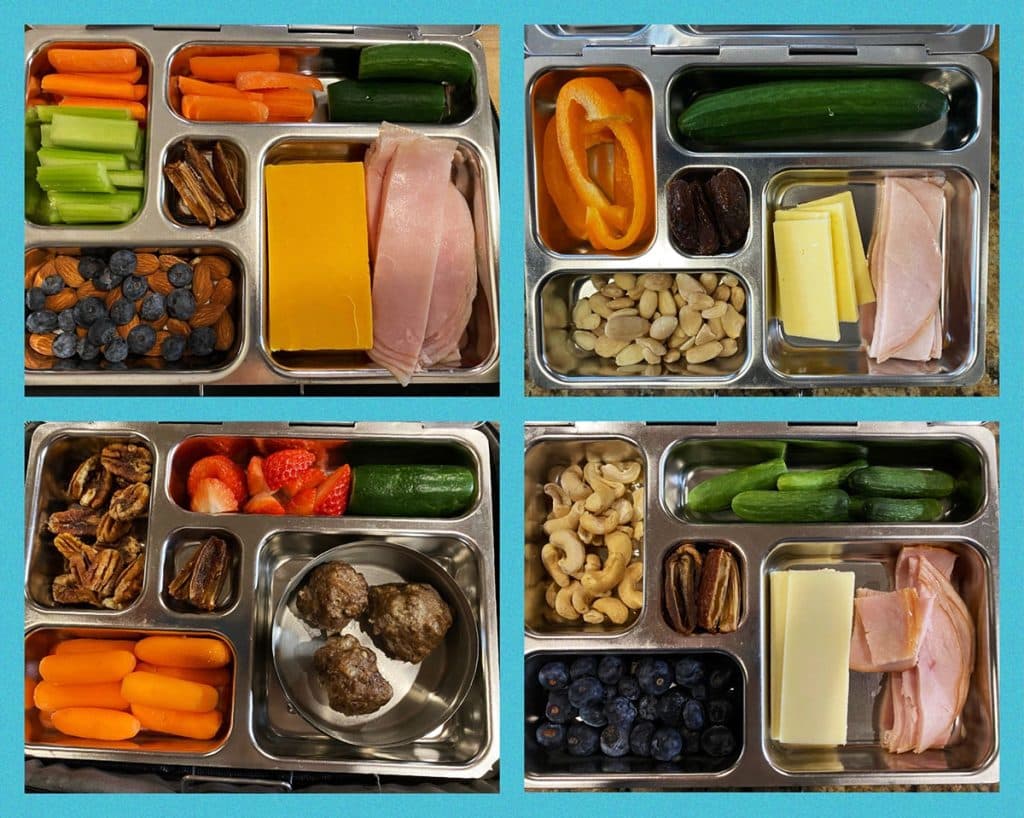
For DS9 we use a stainless steel PlanetBox lunchbox. It zips into a fabric case, which has a couple of pockets on the outside. I usually add things like raisins, apples or oranges to those pockets. The only issue we ran into this month was him asking me to send him with more food!
Dinner
I made a list, for every single day, by date, of what to make for dinner. This was a little bit painful to put together, but wow was it freeing once I had it to refer to! I put down about two weeks worth of full GAPS friendly dinners, and as time passed, I filled it out with recipes we liked or generic favorites (like steak and steamed veggies) or new GAPS recipes as I find time to search the net or look in cookbooks for more. Occasionally this month I did forget to thaw meat or marinate things and so needed to shuffle dinners around, but at no point have I had to figure out what to make for dinner on that day.
And that is just how I like it!
Snacks
A posted list is on the pantry door for the kids entitled “What Can I Eat?” Put down all the things you can think of that fit your selected style of eating and that you are ok with your family eating at will. Here are just some of the things on our list.
- soaked and dehydrated “crispy” nuts
- yogurt, with or without toppings (see mention in the breakfast section above)
- non-chocolate chip Larabars
- cheese! sliced, cubed, curds, you name it
- eggs, cooked any which way
- grass-fed, uncured meat sticks
- smoothies or smoothie popsicles
- a glass of homemade kefir
- fresh fruit
- fresh veggies
- apples and peanut butter
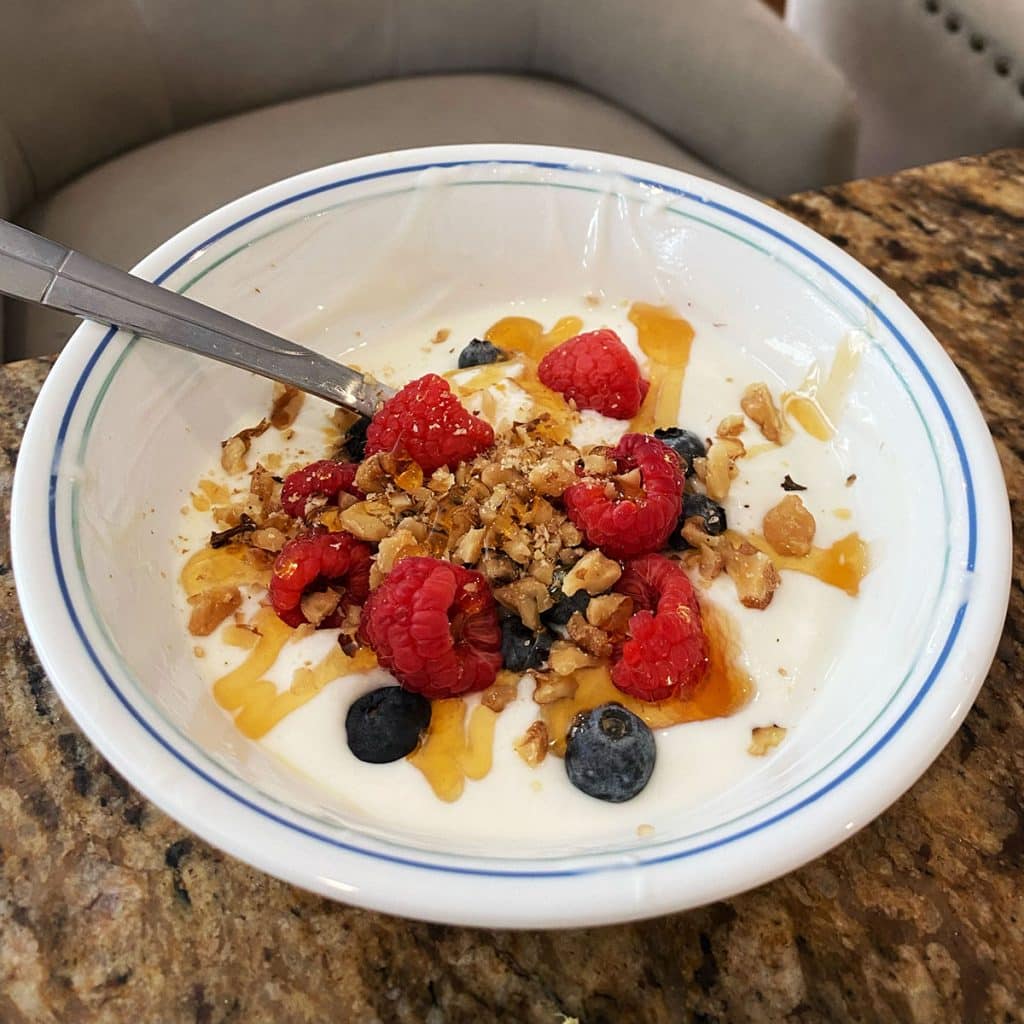
Keep up with demand
I can see at this point that running out of certain staples will be the kiss of death for our healthy diet. What this means is that soaked and dehydrated crunchy nuts, homemade yogurt, hard-boiled eggs (I make two dozen at a time in my Instant Pot), and fruit (so much fruit!!) are things we buy or make a LOT.
I have various grocery store options near me and I’ve figured out where some great deals lie (have you ever bought organic berries or uncured sugar-free bacon at Aldi?? Such a treasure trove that place is!) and so it hasn’t been too much extra work to hit up the store frequently. After awhile, I think I will get a feel for how much to buy so that I can go maybe once a week. I’m sure there are lots of bulk buying options that would be smart as well.
So how did it go??
In a word, great! Those of us doing GAPS intro gradually phased into full GAPS after about two weeks.
My mother’s knee pain, which was very severe before we started, has abated almost 100%. She can sew and quilt for multiple hours without having terrible back pain the next day (true story from right before we started the diet).
The adults have all lost about 10 pounds each. DH reports feeling “peppier” than normal and I am certainly sleeping better.
The kids’ appetites, especially DS9 and DS14, are far bigger than before. My youngest has recently started having 3 scrambled eggs for breakfast, and often asks for an additional couple of fried eggs to eat on the drive to school. Amazing!! I anticipate some growth spurts on the horizon.
DS11 is the toughest nut to crack. His appetite is up, but his pickiness is not quite as improved as I’d hoped. Though he did recently eat fish for dinner, so that was quite a win!
Overall I would brand this as a big success, and I’m very glad we did it.
What's next?
Now that our full GAPS month is over, we absolutely intend to continue many of the good habits we picked up in January. I’m now quite confident that I can make dinners that do not require a starch, though I will begin adding (properly prepared) rice, grains, and potatoes to some of our dinners. I’m excited to learn how to make my own sourdough bread. My kids really missed drinking glasses of raw milk, so that is back on the menu as well.
I will keep the daily dinner meal plan going for the foreseeable future, and my intention is to make as much of our food from scratch as I can. This was an encouraging foray into healthy eating and we all feel motivated to keep up the good work.
Good luck to you and yours if you opt to pursue something similar! ♥
More on GAPS, GAPS-friendly recipes & preparing for GAPS:
Wise Traditions & Homemade Sauerkraut
Quick Fermented Garlicky Beets
Water Kefir SOS: Troubleshooting Your Brew
The Health Benefits Of Soaking Nuts & Seeds
Simple Larabar Inspired Date Bars Using Soaked Nuts

